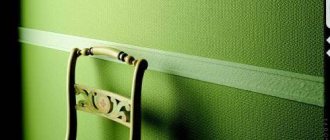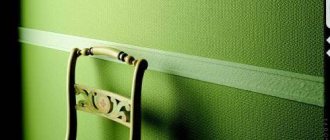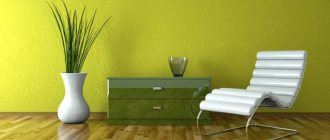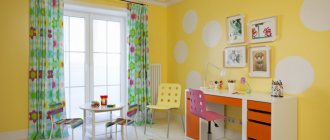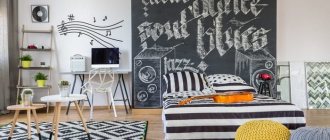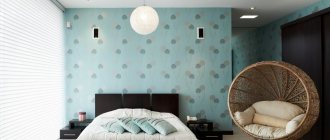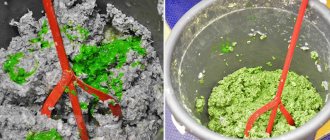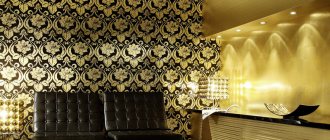Wallpaper coverings have always been the most profitable solution for decorating any room. And their main goal is to create special coziness and comfort in your home.
Liquid wallpaper appeared on our market not so long ago, but its popularity and demand is gaining momentum. With the help of wallpaper, it is easy to set an individual creative style, using a variety of texture and color combinations and application technologies. Actually, this finishing material will be discussed here.
What is liquid wallpaper
In appearance, liquid or wet wallpaper is very similar to “decorative”; even their technological processes are identical. The main difference is in the composition of the mixtures used. Plasters include cement, sand and lime additives, while liquid coatings include glue and cellulose, cotton or acrylic fibers. In addition, they often include glitter (fragments of mica, sparkles, threads, mother-of-pearl).
After we found out what it is, I would also like to add that thanks to the plasticity of the material, the walls remain seamless. Minor surface defects are also easily hidden.
Advantages and disadvantages
Of course, like any finishing materials, liquid wallpaper also has its pros and cons.
Pros:
- great color and texture diversity;
- good sound and heat insulation characteristics;
- resistance to temperature changes;
- when applied, they mask small surface imperfections;
- easy to install and remove;
- quickly restored;
- vapor-permeable composition (does not dampen).
Wet wallpaper is an ideal option for your walls, they are absolutely safe and an environmentally friendly product!
Minuses:
- fade when exposed to the sun;
- the price category is significantly higher than that of its “brothers”;
- inability to use in wet areas;
- require only dry cleaning;
- difficult to apply on smooth surfaces.
Liquid wallpaper consumption
What is the price and consumption of liquid wallpaper per square meter? Experts recommend spending an average of 1 sq.m. 0.5 kg of dry composition. The purchase price directly depends on the area of the room and the presence of external effects.
For an even surface you will need from 0.3 to 0.5 kg. It is also necessary to take into account the inclination and movements of the spatula during the application of the working composition to the walls. For example, if you hold a construction spatula at an angle of 45 degrees, then approximately 0.2 kg will be consumed during application.
Note!
Glass wallpaper - what is it? Pros and cons, types, features, characteristics, photos of design and combinations in the interior
Plain wallpaper - 150 photos of modern design. Rules for choosing and combining wallpaper in the interior: kitchen, bedroom, living room, hallway
Wallpaper framed on the wall in the interior: photos of original design and beautiful decor
Application technology
Do not rely entirely on manufacturers' recommendations! It is better not to use wet wallpaper on curved walls. Firstly, this leads to an increase in the volume of consumables, the price of which is significantly higher than conventional putty. From an economic point of view, it is cheaper to pre-prepare the wall. Secondly, if there are large irregularities, the mixture may appear in spots, and the background will have to be leveled. Areas with thick layers will be dark, areas with thin layers will be light, which will entail additional costs.
Surface preparation
Wall decoration with any liquid wallpaper requires some preparatory work:
- The surface is first cleaned of existing contaminants and old wallpaper is removed.
- The walls are puttied with high quality and treated several times with primer to give them a rough finish.
- If the primer did not hide the previous uneven tones, it is better to additionally paint the surface.
- The presence of metal elements (screws, nails) in the walls is not welcome; they must be removed. Otherwise, rust will appear and ruin the entire appearance. In particularly difficult situations, you can try to paint them, for example, with water-repellent paint, and its shade should match that at the base.
Preparing the mixture
If you decide to apply wallpaper yourself, it is important to prepare the working mixture correctly. Be sure to follow the guidelines below:
- Prepare a large container and pour in the finishing material. Next, fill everything with warm water (30–35 °C).
- Stir the solution until the thick minced meat is homogeneous. You can use either a construction mixer or knead the mass by hand.
- Transfer the prepared mixture into a bag and tie it. Wet wallpaper should sit and swell; this will take about 5–10 hours.
- To avoid visible boundaries and seams, you should prepare at once the entire volume needed to finish a room or a wall.
Another advantage of liquid wallpaper is that areas you don’t like can be easily removed with a spatula. The material is soaked again, kneaded and applied to the surface.
What substances are used for production?
To create this version of the finishing material, the following components are used:
- Adhesive base. This material is made in the form of a dry powder, which after contact with water increases in size and promotes adhesion of the decor to the concrete plane;
- Dyes. They allow you to paint the working composition in the required shade;
- Pulp of different sizes. For the production of liquid wallpaper, paper of different compositions and strengths is used. It is she who sets the texture and volume on the surface of the wall;
- Small fibers of silk threads. They provide the finished surface with shine and silky texture;
- Antiseptics and fungicides. These substances prevent the growth of bacteria and fungi on the surface;
- Decorative details in the form of mica, mother-of-pearl chips, sparkles of different diameters and mineral chips.
The material for decorating the interior space is sold in the form of a dry powder, which is pre-packaged in containers of different diameters. The shelf life of such finishing material is from 10 to 15 years.
How to make liquid wallpaper with your own hands
Making homemade wall coverings is quite simple. For this you will need:
- various waste paper;
- gypsum;
- water;
- PVA glue;
- colors;
- some additives (quartz or marble dust, wood shavings, mica, glitter).
To accurately make wallpaper from these and other materials with your own hands, you must carefully follow the step-by-step instructions:
- Take a 12 liter bucket and fill it with water.
- Place finely chopped paper in the water.
- We give time for all the paper pieces to thoroughly liquefy.
- Using a mixer, bring the mixture to a homogeneous consistency.
- Add decoration elements, glue and pigments.
- Mix again.
- We add plaster.
Important! Gypsum should be added to wet wallpaper for your walls in the amount that you have time to work out, otherwise the mixture will harden and become unusable!
Coatings using other components
There are other options for homemade mixtures. They are based on various insulation materials, pieces of cotton wool, fibrous wood pulp, fragments of twine, leather, wool, cotton, silk or cellulose fibers.
The interior solution will depend on which composition you prefer.
The disadvantages of hand-made liquid wallpaper can only manifest themselves due to the consumption of low-grade components. In addition, technological errors often have an impact when the solution peels off or forms lumps.
Stylish wet wallpaper: photo
Modern wet wallpapers are presented in a wide range, so everyone can easily choose the desired option.
Modern manufacturers present many different options for wet wallpaper
In particular, it is worth highlighting the wallpaper:
- French;
- Turkish;
- Russian;
- Danish made.
Related article: Ceiling panels in a room: cheap and beautiful
Wet wallpaper produced in France is characterized by quite rich colors and contains only natural ingredients and high-quality bright dyes. It is quite possible to apply such wallpaper on almost any surface, and in order to increase its moisture resistance, it is advisable to additionally cover it with a layer of varnish. Turkish liquid wallpaper is in no way inferior in quality to French products, but has a much lower cost. Russian wet wallpaper is more viscous in its consistency, which allows it to be used not only as a decorative covering, but also as a means for leveling walls.
Wet wallpaper produced in Denmark is characterized by the fact that the mixture, already diluted with water, is uniformly white in color. It is quite possible to add various coloring components and decorative elements to it, thereby creating an excellent color scheme. Caring for such coatings is quite simple; they can be easily wiped with a damp cloth, as well as cleaned with a vacuum cleaner. If stains form on the surface, it is quite possible to remove them using any stain remover.
Application to walls and ceilings
The method of applying liquid coatings is similar to the plastering process. After all the tools and working mixture are prepared, perform the following steps:
- The wet wallpaper is distributed along the entire length of a wide spatula and spread over the plane in a circular motion.
- Work should begin from the middle of the upper fence, rubbing the composition from top to bottom, then on the sides of the central part of the fence.
- Try to process the entire surface, this will help avoid visible joints. If you don’t have time, thoroughly spray the joint with water, wait about half an hour and start finishing.
- Liquid wallpaper with various flaws on the wall can be quickly cleaned and corrected with a new liquid mass.
- Spatulas with a narrow blade are used to remove internal and external corners.
- To speed up the drying process, which lasts on average two days, you can use heaters, air conditioners, or create drafts.
Roller application
To reduce the time of working with liquid mass, we suggest considering the option of using a special roller. It is better to apply wet wallpaper with a tool with a hard short pile with a surface width of no more than 15 cm. Foam or fur rollers are also suitable, but they must be hard.
Here the technology itself is a little different. Therefore, following the manufacturer’s recommendations, we prepare the mixture and try to distribute it over the wall. If it doesn’t rub well, dilute it with water. Knowing a lot about liquid wallpaper and its disadvantages, we do not overdo it with water so that the solution does not flow down the surface.
Then we apply the finished mass to a spatula and “pat” it on the wall, after which we roll it out with a roller. Subsequent steps are the same. Apply the solution and roll it out.
The roller is quite convenient when working with uneven surfaces; it makes it easy to maintain uniform layer thicknesses!
But that’s not all: you can add the following about the roller and liquid wallpaper. Using this tool allows you to give a wall or ceiling a textured look, which looks very interesting. If you don’t like this, go around everything with a spray bottle, and after 15–20 minutes smooth the relief with a dampened trowel.
Liquid wallpaper application technology
How to apply liquid wallpaper? Experts have developed several methods for applying the working composition to a vertical and horizontal plane. They include:
- To finish the ceiling, use a flat spatula. A small amount of the working composition is applied to it. Next, the decorations are evenly distributed in a circular motion. The surface is first carefully treated to remove external defects and primed;
- For finishing the kitchen, we recommend purchasing an additional supply of consumables. The corner parts of the space are treated with the working composition. Movements are carried out from bottom to top;
- To treat plasterboard structures, the entire frame is puttied with a finishing mixture. After this, it can be coated with acrylic paint.


